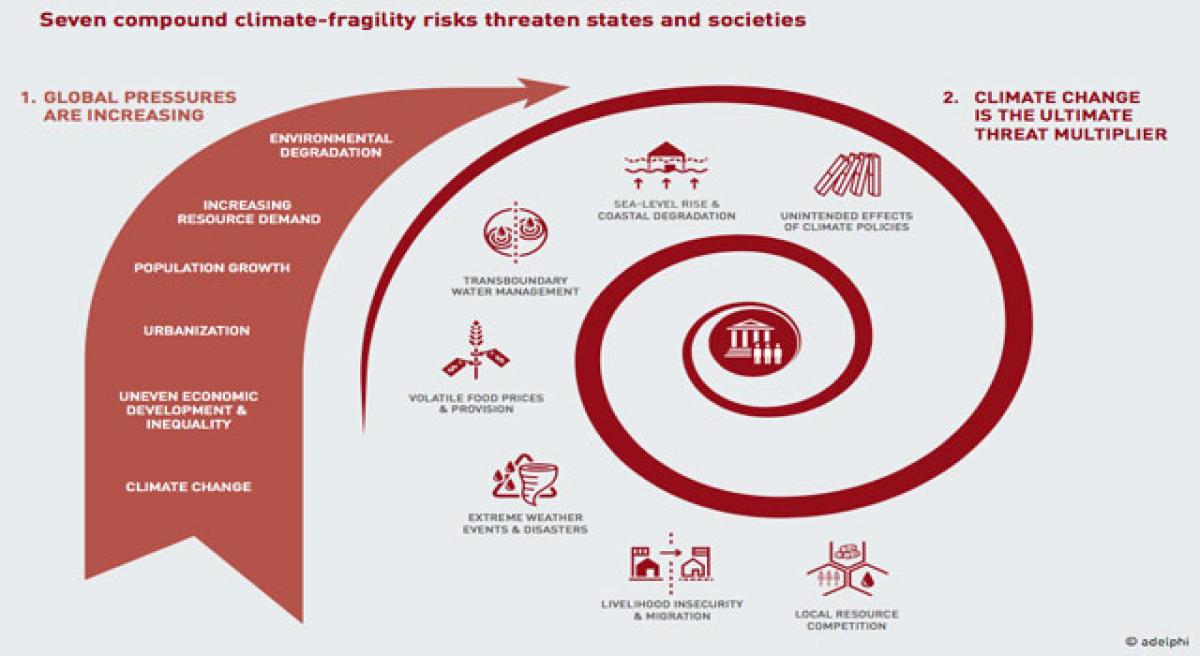Live
- ‘One nation, one election’ will undermine India’s federal structure: Mehbooba Mufti
- ‘Bachhala Malli’ trailer heightens anticipation
- Karnataka quota row: Backward Class forum chief warns Lingayat seer over 'tinkering with reservations'
- Tight security arrangements at Group-II examination centers District SP
- Alia Bhatt captures attention in white
- Varun Dhawan talks about ‘Baby John’
- ‘Moonwalk’ trailer promises a quirky heist, love, and loyalty
- Combat leaf spot disease
- Ahsaas Channaopens up about her complex character in ‘Mismatched 3’
- Radhika Apte welcomes first child, shares heartfelt post
Just In

In a recent article for New Security Beat, Colin Walch made the case that the abandonment of some communities in Mali to deal with climate change on their own has created \"fertile ground\" for jihadist recruitment.
In a recent article for New Security Beat, Colin Walch made the case that the abandonment of some communities in Mali to deal with climate change on their own has created "fertile ground" for jihadist recruitment.
In a similar argument, Katharina Nett and Lukas Rüttinger asserted that "large-scale environmental and climatic change contributes to creating an environment in which [non-state armed groups] can thrive and opens spaces that facilitate the pursuit of their strategies."
These are important findings and relevant studies that point to the multifaceted security risks that result from climate change. They moreover confirm that climate change does not act as a cause of violence, but as a meaningful threat multiplier. But we also need to move beyond a singular focus on risk.
We need to put opportunity and peace back at the centre of environmental peace and conflict research and practice. In fragile states, we need to strengthen our efforts to identify the potential that climate action has to overcome fragility and improve people's lives, not just focus on threats. This requires both a better understanding of what works on the ground and clear global leadership.
So what builds peace? This was a core question during the Stockholm Forum on Peace and Development this spring during discussions about the Sustainable Development Goals, also known as "Agenda 2030", and how they relate to peace and conflict. The answer from panellists was unanimous: Include local communities in the development processes.
The evidence base for the effect of significant local involvement in climate, development and peace-building projects is substantial. Recent research that pays close attention to the links between socioeconomic, political, as well as ecological processes offers valuable pathways for climate action that could address the threats to people's livelihoods that terror groups exploit in order to bolster recruitment.
As Walch persuasively shows for Mali, it is the breaking down of local institutional structures that provides opportunities for jihadist recruitment. My research in Nepal, as well as Prakash Kashwan in India, Tanzania and Mexico, shows that good climate mitigation policies can also build such institutions up, or at least help in the emergence of new local governance structures.
In Nepal, I tested whether the provision of environmental services helps in the facilitation of the peace process after civil war. Looking specifically at climate-sensitive small hydropower projects designed to bring electricity to rural villages, this research showed not only substantial socio-economic successes -- e.g. regarding empowerment for women, better access to education, and increased economic opportunities -- but an increase in community cohesion and strengthening of local governance structures.
The results indicate that climate policies can play an important role in facilitating the growth of local institutions and addressing peoples' vulnerability and fragility (even if, as in this case, it was somewhat unintentional and raises other political issues). Likewise, Kashwan shows in his recent book, "Democracy in the Woods", that REDD+ forest policies in India, Tanzania and Mexico depend on the inclusion of local communities to be successful. He argues that "when local people do not benefit, forest conservation efforts tend to be unsustainable".
Kashwan lays out the argument that national leaders and dominant political parties that must compete for popular support are more likely to fashion local interventions that pursue conservation of forested landscapes without violating the rights of forest-dependent people than leaders and political parties that are not accountable to constituents.
He argues that state and non-state agencies, including international agencies, can foster and reinforce the responsiveness of government by strengthening the skills of community groups and civil society organisations at the local level. As their capacities for organisation and advocacy improve, they are able to better represent their concerns, including during negotiation over natural resource rights, as in the case of inter-ethnic grievances in Mali.
This research offers valuable examples that climate action can mitigate not only the effects of climate change, but have wider impacts that deliver positive returns in all manner of ways, like reducing the opportunity for terrorist groups to recruit vulnerable and marginalised people to their cause. At all levels, it is imperative that we emphasise the positive potential of sustainable policies beyond risk assessments, especially for fragile states, where there will always be risks, but great opportunity too. (In arrangement with thethirdpole.net)
By Florian Krampe

© 2024 Hyderabad Media House Limited/The Hans India. All rights reserved. Powered by hocalwire.com







